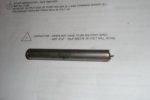Hi all,
I'm following this thread with a great deal of interest since I get a small spark when I complete the circuit to my batteries and because I also have a good sized dent in my currently installed capacitor. I have not yet tried to use a DMM to confirm it is either shorted or open since my main concern until recently has been to get my unit running again, but I suspect the worst.
I've done a little research and I've found that these tantalum capacitors are quite special in terms of their stability, longevity and environmental tolerance. For this reason, they are used extensively in aerospace applications (nothing is too good for uncle sam, hey?). They currently come in two types, solid and wet. I believe ours may be the wet variety, but they could also be an earlier design. In addition to their above attributes, they also can pack a really large capacitance into a small volume, and they are very expensive, relative to ordinary capacitors. Attached is a data package from Vishay which provides a detailed description of their current line of mil-spec wet tantalum axial lead capacitors. It likely contains more than you would ever want to know, and may provide some good bedtime reading:
View attachment Data on Vishay MIL-SPEC wet tantalum capacitors.pdf
It appears that the mil-spec that LuckyDog cited, 39006/2, may have been superseded, since the Vishay data package does not list it, but does list some that were apparently written later (/09, /21, /22, /25, /30 and /31).
An additional complication is that the technology has changed, and continues to change. For more bedtime reading, see the following:
View attachment twa_series.pdf
Did I say expensive? Here is a link to what is currently available from Mouser. These are not mil-spec, but are similar:
Mouser Electronics - Electronic Component Distributor Tantalum Capacitors - Wet
Prices are per single capacitor, and vary depending on how many are ordered. These may not be quite as good as the mil-spec versions, but I have not been able to find pricing/availability of their mil-spec counterparts.
Here is a look at what is available from TEDSS. These look more like replacements "in kind", since they have similar physical dimensions. I believe they may be mil-spec, but they are even pricier and say "tantalum foil" instead of "wet tantalum":
CL23BL500TNE: 50uF 75V Tantalum Foil Capacitor (Axial Leads)
So given the situation, what to use for a replacement? I'm far from expert on this topic, but my current sense is that although it does not need to be a replacement "in kind", it probably should be a wet tantalum capacitor in order to ensure that it complies with its electical requirements for very long in this operating environment. Like n10ty, I'd be concerned about dissipation factor if there was a dramatic size difference between the original and replacement, since the ability to shed heat is directly related to surface area. On the other hand, the capacitors listed in the Vishay data are all much smaller than the take-out cap, yet some of them have really large dissipation factors. Perhaps dissipation factor is not limited by surface area.
I may replace my cap with one like these:
eBay - New & used electronics, cars, apparel, collectibles, sporting goods & more at low prices
I really like the price, but I'm not happy that they are only rated for 50V.
The other concern I have is that the shedding of leads appears to be a very common failure mode for these caps in this particular environment. I suspect this may be due to environmental vibration setting up resonant frequencies in the leads which results in eventual metal fatigue. I wonder if shrink wrapping the leads would prevent this from happening.
In addition, I would really like to know what the implications are for continuing to run the genset with a failed cap. Do the unsurpressed voltage spikes and ripple from the alternator eventually cook the charging circuit rectifier/voltage regulator, or were these capacitors installed only to provide RF supression?
Best regards,
Stan



